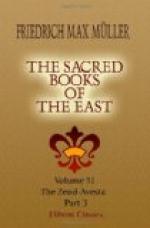The essay published in 1831 by Peter von Bohlen on the origin of the Zend language threw the matter forty years back. According to him, Zend is a Pracrit dialect, as it had been pronounced by Jones, Leyden, and Erskine. His mistake consisted in taking Anquetil’s transcriptions of the words, which are often so incorrect as to make them look like corrupted forms when compared with Sanscrit. And, what was worse, he took the proper names in their modern Parsi forms, which often led him to comparisons that would have appalled Menage. Thus Ahriman became a Sanscrit word ariman, which would have meant “the fiend”; yet Bohlen might have seen in Anquetil’s work itself that Ahriman is nothing but the modern form of Angra Mainyu, words which hardly remind one of the Sanscrit ariman. Again, the angel Vohu-mano, or “good thought,” was reduced, by means of the Parsi form Bahman, to the Sanscrit bahuman, “a long-armed god.”
At length came Burnouf. From the time when Anquetil had published his translation, that is to say during seventy years, no real progress had been made in knowledge of the Avesta texts. The notion that Zend and Sanscrit are two kindred languages was the only new idea that had been acquired, but no practical advantage for the interpretation of the texts had resulted from it. Anquetil’s translation was still the only guide, and as the doubts about the authenticity of the texts grew fainter, the authority of the translation became greater, the trust reposed in the “Avesta” being reflected on to the work of its interpreter. The Parsis had been the teachers of Anquetil; and who could ever understand the holy writ of the Parsis better than the Parsis themselves? There was no one who even tried to read the texts by the light of Anquetil’s translation, to obtain a direct understanding of them.
About 1825 Eugene Burnouf was engaged in a course of researches on the geographical extent of the Aryan languages in India. After he had defined the limits which divide the races speaking Aryan languages from the native non-brahmanical tribes in the south, he wanted to know if a similar boundary had ever existed in the northwest; and if it is outside of India that the origin of the Indian languages and civilization is to be sought for. He was thus led to study the languages of Persia, and, first of all, the oldest of them, the Zend. But as he tried to read the texts by help of Anquetil’s translation, he was surprised to find that this was not the clue he had expected. He saw that two causes had misled Anquetil: on the one hand, his teachers, the Parsi dasturs, either knew little themselves or taught him imperfectly, not only the Zend, but even the Pahlavi intended to explain the meaning of the Zend; so that the tradition on which his work rested, being incorrect in itself, corrupted it from the very beginning; on the other hand, as Sanscrit was unknown to him and comparative grammar did not as yet exist, he could not supply




